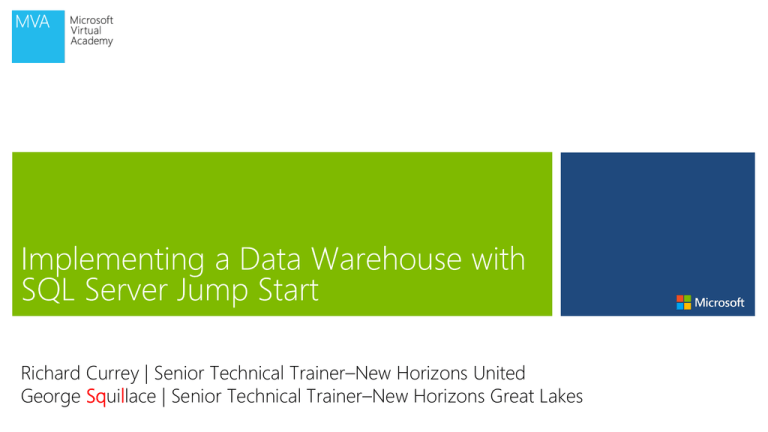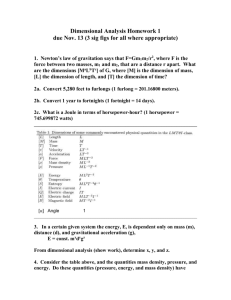
Richard Currey | Senior Technical Trainer–New Horizons United
George Squillace | Senior Technical Trainer–New Horizons Great Lakes
Meet Richard Currey
• Senior Technical Trainer – New Horizons United
– Focused on database and development technologies
– MCDBA, MCITP Dev / Admin / BI, MCSE Data Platform, BI
– MCSD, MCPD Web Developer, ASP .NET Developer, Windows
Developer
• 28 Years Industry Experience
– Designed, developed and managed BI-centric projects at
several Fortune 500 organizations
– Extensive consulting and project management background
Meet George SQUILLACE
• Senior Technical Trainer – New Horizons Great Lakes
(20 Years)
– “SQL” is in his name!
– Focused on database technologies
– MCT Since 1997
• 28 Years Industry Experience
– SQL Server 2012: certified as MCSA, MCSE: Data Platform, &
MSCE: Business Intelligence
– Certified in every version of SQL Server since SQL 2000
– Certified in every version of Windows Server from NT 4.0
through Windows Server 2008
– Certified in Exchange Server 5.5 through Exchange Server
2007
Course Modules
Implementing a Data Warehouse with SQL Server
01 | Design and Implement Dimensions
and Fact Tables
04 | Control Flow
02 | Data Flow - Extract Data
05 | Configure and Deploy SSIS
03 | Data Flow - Transform Data
06 | Manage Enterprise Data
Setting Expectations
• Target Audience
– Data warehousing specialists who want to expand their knowledge of SQL Server
Integration Services (SSIS)
– Database professionals who want to take exam 70-463 and get certified in data
warehouse implementations
• Suggested Prerequisites/Supporting Material
– SQL Server development experience and exposure to extract, transform, and load
(ETL) processes
– Course 10777, Implementing a Data Warehouse with Microsoft SQL Server 2012
– MS Press Book: Training Kit (Exam 70-463): Implementing a Data Warehouse with
Microsoft SQL Server 2012
01 | Design and Implement Dimensions
and Fact Tables
Richard Currey | Senior Technical Trainer–New Horizons United
George Squillace | Senior Technical Trainer–New Horizons Great Lakes
Module 1 Overview
• Schema Design: Star vs. Snowflake
• Facts and Fact Tables
• Fact and Dimension Granularity
• Conformed and Non-Conformed Dimensions
• Time Dimensions
Topic: Schema Design: Star versus Snowflake
• Star Schema
• Snowflake Schema
• Processing and Performance Considerations
Star Schema
DimSalesPerson
SalesPersonKey
SalesPersonName
StoreName
StoreCity
StoreRegion
• A star schema has a single
table for each dimension
• Each table supports all
attributes for that dimension
• Typically a de-normalized
solution
DimCustomer
CustomerKey
CustomerName
City
Region
DimProduct
ProductKey
ProductName
ProductLine
SupplierName
FactOrders
CustomerKey
SalesPersonKey
ProductKey
ShippingAgentKey
TimeKey
OrderNo
LineItemNo
Quantity
Revenue
Cost
Profit
DimDate
DateKey
Year
Quarter
Month
Day
DimShippingAgent
ShippingAgentKey
ShippingAgentName
DEMO
Implementing a Star Schema
Snowflake Schema
• More normalized solution
• Typically contains multiple
tables per dimension
• Each table contains
dimension key, value, and the
foreign key value for the
parent
DimStore
StoreKey
StoreName
GeographyKey
DimGeography
GeographyKey
City
Region
DimCustomer
CustomerKey
CustomerName
GeographyKey
DimProductLine
ProductLineKey
ProductLineName
DimSalesPerson
SalesPersonKey
SalesPersonName
StoreKey
FactOrders
CustomerKey
SalesPersonKey
ProductKey
ShippingAgentKey
TimeKey
OrderNo
LineItemNo
Quantity
Revenue
Cost
Profit
DimProduct
ProductKey
ProductName
ProductLineKey
SupplierKey
DimDate
DateKey
Year
Quarter
Month
Day
DimShippingAgent
ShippingAgentKey
ShippingAgentName
DimSupplier
SupplierKey
SupplierName
DEMO
Implementing a Snowflake Schema
Processing and Performance Considerations
• Star schema requires de-normalization during the load process
– Can impact the ETL times
• Snowflake schema can increase dimension complexity
– Can impact Analysis Services solutions, negatively affecting cube
performance
Topic: Facts and Fact Tables
• What Is a Fact?
• Grouping Facts
• What Is Granularity?
• Design Considerations
What Is a Fact?
• Facts are the key metrics used to measure business results:
– Sales
– Production
– Inventory
• Can be additive, semi-additive, or non-additive
Grouping Facts
• Facts are grouped into fact tables
• Related facts should be in the same fact table
• Facts with different granularity should be in different tables
What Is Granularity?
• Granularity refers to the level of detail in which facts are
recorded
• Facts can be at different levels of granularity
Design Considerations
• Fact tables should have all keys relating to dimensions
• Primary key should be composite of all dimension keys
• Separate additive, semi-additive, and non-additive facts
Topic: Fact and Dimension Granularity
• How to Determine Fact Granularity
• Dimension Granularity
How to Determine Fact Granularity
• Granularity is determined based on business needs
• Should be the lowest level of detail that needs to be examined
• If data from transactional systems has more detail than needed
for analysis, ETL should aggregate the details
Dimension Granularity
• Dimension granularity needs to be matched with fact granularity
• Each dimension has its own granularity
• Fact tables are keyed to the granularity of the dimensions
Topic: Conformed and Non-Conformed Dimensions
• What Are Conformed and Non-Conformed Dimensions?
• Shared and Degenerate Dimensions
• What Is a Slowly Changing Dimension?
What Are Conformed and Non-Conformed
Dimensions?
• Conformed dimension
– Shared by multiple fact tables
– Used when all business users have the same definitions for the
dimension
• Non-conformed dimension
– Dimension table targeted to a single fact table
– Used when dimensions have different definitions for different business
units
DEMO
Creating Conformed and Non-Conformed Dimensions
Shared and Degenerate Dimensions
• Shared dimension
– Used by multiple facts
– Dimension key is stored in the fact table
– Dimension value is stored in the dimension table with other attributes
of that dimension
• Degenerate dimension
– Used by a single fact table
– Dimension value is stored directly in the fact table
– No corresponding dimension table
What Is a Slowly Changing Dimension?
• When the historical attribute values are retained if the attributes
are updated
• Used when the organization does not want to lose track of what
actually happened
– Example: customer moves from Connecticut to Seattle
• Slowly changing dimension types:
– Type 1: Attribute history is not retained
– Type 2: Attribute change creates a new record
– Type 3: Original attribute value recorded and latest value recorded with
an effective date
DEMO
Implementing a Slowly Changing Dimension
Topic: Time Dimensions
• Types of Time Dimensions
• Time Dimensions and Hierarchies
Types of Time Dimensions
• Based on standard calendar breakdowns
– Year => Month => Day
– Year => Quarter => Week => Day
• Based on fiscal calendar
– Year => Fiscal Quarter => Fiscal Month => Fiscal Week => Day
• Time dimension needs to contain all hierarchy elements to the
lowest granularity for the fact tables
Time Dimensions and Hierarchies
• Establishes the “buckets” that the business uses
• Typically there are multiple hierarchies in the dimension
– Calendar
– Business
• Created using Microsoft Excel, scripts, or are auto-generated
DEMO
Creating a Time Dimension
©2013 Microsoft Corporation. All rights reserved. Microsoft, Windows, Office, Azure, System Center, Dynamics and other product names are or may be registered trademarks and/or trademarks in the U.S. and/or other countries. The information herein is for
informational purposes only and represents the current view of Microsoft Corporation as of the date of this presentation. Because Microsoft must respond to changing market conditions, it should not be interpreted to be a commitment on the part of Microsoft, and
Microsoft cannot guarantee the accuracy of any information provided after the date of this presentation. MICROSOFT MAKES NO WARRANTIES, EXPRESS, IMPLIED OR STATUTORY, AS TO THE INFORMATION IN THIS PRESENTATION.






